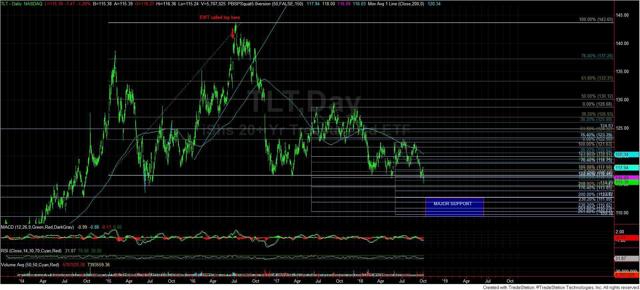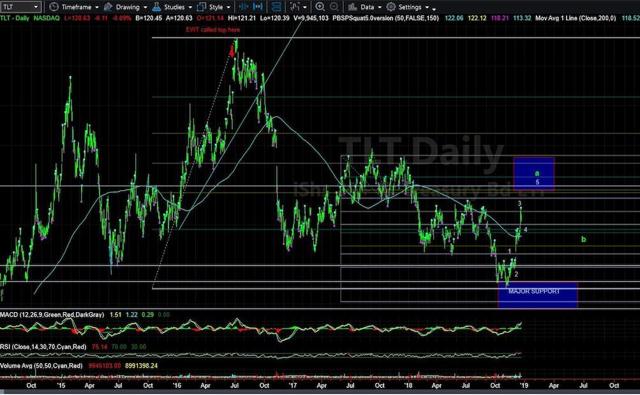By Avi Gilburt
One of my members laughingly posted an article in our chatroom entitled "Riding the Bond Rally No One Saw Coming." Were you one of the many who did not see this rally coming? The point my member was trying to make was that while we were preparing for this rally since October of 2018, it seems most of the market was surprised by the rally.
Before I address how we have handled the bond market in 2018 and 2019, let me take you back through the last 3 years within the bond market.
As the bond market rallied on for decades, one analyst after another attempted to “call the top.” Yet, the bond market continued higher and higher.
Back on June 27th 2016, I wrote an article entitled “Beware of Bonds Blowing Up.” And, that was my first article calling for a top in the bond market. As we now know, within two weeks after I published that article, the bond market struck a major top which has not been exceeded in almost 3 years. In fact, TLT dropped 22% since it struck its high two weeks after my article.
Then in October of 2018, I started preparing the members of TMPW for an impending bottom. In fact, I noted that once we break below 113 in TLT, I intend to be buying. This is what my chart looked like in October of 2018:

And, in less than two months after striking the bottom, TLT was already approaching my first target of 124, after which I expected a b-wave pullback.

So, we can fast forward to March 5th, and I published an article on Seeking Alpha warning readers that “Bonds Are Setting Up To Skyrocket.” And, what was the response? Here is a sampling:
“Going to have to fade this call. Shorting TLT at 121.20.”
“I think Avi left his mind on the seat when he went out of the movie. If we told the Fed this, you could hear the laughter all the way down PA Ave.”
“Hard to get excited about an investment that returned 4.45% the last 10 years.”
“I started shorting TLT on 2/25. . . There's tremendous potential downside and very minimal upside on TLT. Only one way I would ever trade TLT at these rates, and that's down.”
“With all due respect, I'm going to take the other end of this trade for the remainder of 2019”
“I have no idea why Avi thinks it is going higher. There are so many reasons to the contrary.”
“How does it make any sense to expect long bonds to rally here? This slight rally is an attractive selling opportunity here. . . Rates are headed higher. Treasury is a bear. I am on the opposite side of this one. “
“Betting on moves in long term rates seems like picking up pennies in front of a steam roller. Ten bps move and you are crushed”
And, these are just a sample of the posts to my recent bond articles. Clearly, you can see that there was a sizeable segment of the market which disagreed with my perspective. It seems that these posts represented the general negative sentiment of the bond market overall. Moreover, when the market is generally this negative, it quite commonly moves in the opposite direction.
Now, consider that these comments were made even AFTER TLT had completed its initial rally from the 113 region to my first target of 124. In other words, we still have many bears left in the market despite an almost 10% rally in bonds.
So, when I initially began buying TLT just below 113 in early November (before that 10% rally), the comments presented even greater disbelief. And, the main reason many disagreed with me at the time is represented by these two comments:
“the Fed is still raising rates and you want to go long bonds?”
“Don’t you realize you cannot fight the Fed?”
You see, the market was quite entrenched in the downtrend into the November lows, and just like most market participants always do, they expected the immediate trend to continue unabated. But, what is more surprising is that many remained entrenched in that prior decline even after a 10% rally off the lows.
And, in case you did not recognize some of the comments above, almost half the comments are from “professionals” in the industry. But, as I have noted before, even professionals are not immune from being swayed by the pervasive negative sentiment of the market near the bottom. In other words, professionals are just as influenced by herding as are all market participants.
In 1996, Robert Olson published a study in the Financial Analysts Journal in which he studied the effects of herding upon “expert” fundamental analysts’ predictions of corporate earnings. After studying 4000 corporate earnings estimates, he arrived at the following conclusion:
Experts’ earnings predictions exhibit positive bias and disappointing accuracy. These shortcomings are usually attributed to some combination of incomplete knowledge, incompetence, and/or misrepresentation.
Mr. Olson’s article suggests that “the human desire for consensus leads to herding behavior among earnings forecasters,” with the herd always looking for the current trend to continue unabated and indefinitely. Sound familiar?
Lastly, when I published my expectation for another rally in TLT in early March, many attempted to relate that expectation to a decline in the stock market. So, recently, I penned an article on FATrader.com explaining why this is a wrong perspective to take, and you can read that here.
In the coming days, TLT will approach its next test. If it will be unable to move through the 127.25 level, then we will likely see a pullback lasting for at least a week before we head up to the 128 region. However, if we see a move in the coming week through the 127.25 level, and we are able to continue strongly through 128, then we will be targeting the 130/131 region next. In other words, the market will likely decide shortly if it will be providing us with larger degree extensions or not. But, as long as all pullbacks hold over 124, I still see a rally to at least the 128 before I even consider it to potentially be topping.

